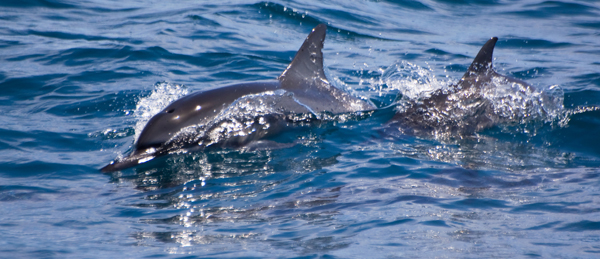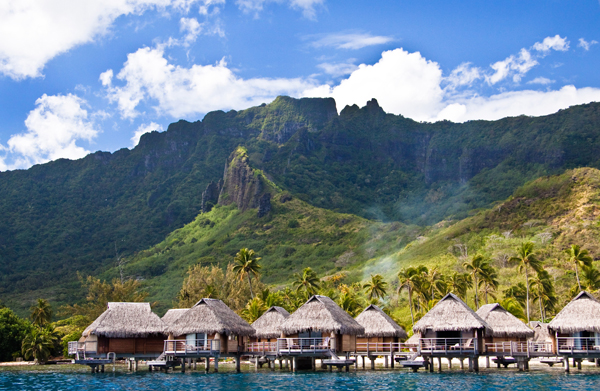MOOREA, FRENCH POLYNESIA - “Off to the left!” announces Dr. Poole as we all turned our heads in unison to see the pod of spinner dolphins off the port side of our boat. Dancing and playing as if for our viewing pleasure, sometimes spinning in the air — as their name suggests; these magnificent mammals cavort around, oblivious to global warming, economic slowdowns and national debt issues.
Like those of us lucky enough to be part of one of Dr. Michael Poole’s excursions out in the open water, thoughts of such mundane affairs are as far from our minds as we are from western civilization — almost 6,600 kilometres southwest of Los Angeles. One couple on our tour is on board for their 12th time, always amazed at what they see.
Born in England of American parents, Dr. Poole’s father was in the U.S. Air Force and they were stationed in Bermuda for three years when he was a young boy.
“I fell in love with the ocean and islands, and saw humpback whales migrate by Bermuda. I decided that when I grew up I would live on an island and be a marine biologist,” he recalls fondly.
“We also lived on the Gulf of Mexico, and when fishing with my father we sometimes saw dolphins. So I decided to work with whales and dolphins. When in high school, and then later at the University of Miami, I chose the Tahitian islands as my final destination.”
Being one of the world’s foremost experts on spinner dolphins, humpback whales and other marine mammals, Dr. Poole has been featured in numerous media specials or reports — TBS, ABC’s Nightline, Good Morning America, Discovery Channel, Animal Planet, National Geographic TV — and he was a scientific consultant for both the extraordinary BBC/Discovery Channel series The Blue Planet and Planet Earth.
The primary focus of his eco-tours is to search for and find schools of acrobatic spinner dolphins. Also often seen are rough-toothed dolphins and pilot whales. And if lucky, from July to early November, one can see those spectacular giants, humpback whales. That was our hope as we set off today, being at the trailing edge of the humpback calving season.
These are truly open-sea encounters with wild, free-ranging creatures in their natural habitat. No trained tricks — no forced proximity. This totally natural encounter is the real or ‘eco-version’ of the usual dolphin experience; the quintessential encounter, thus the popularity of his tours. This is a much different experience than most ‘Dolphin Encounters’ where you swim with captive dolphins in an enclosed, shallow pen — one of which exists here in French Polynesia to Dr. Poole’s chagrin.
“That kind of environment is only several dozen metres wide and less than five metres deep; our local spinner dolphins living around this island can travel 30 kilometres (half way around Moorea) in a single day or night and they can dive 300 metres when hunting their food. The contrast in the two respective environments couldn’t be greater,” says Dr. Poole.

Above: Eco tours of Moorea are usually escorted by lots of dolphins.
The local spinner dolphins live permanently in the vast lagoon and open sea around Moorea, and many of the individuals are known by name to Dr. Poole and his team. While Dr. Poole does not recognize any in this particular pod, amongst the dolphins to our left are two baby dolphins or ‘calves’ as they are known, who with the rest of their pod approach our boat curiously. They are very active with their playing and cavorting, all the time our cameras clicking and videos whirring. One dolphin shows the recent signs of a shark encounter — a bright red ‘cookie cutter shark’ bite. While the dolphins are close to the boat, we learn facts, figures and other interesting details of these remarkable creatures and their complex societal interactions from Dr. Poole.
Prior to seeing this dolphin pod, we started the trip in a reef pass where dolphins are frequently seen, but we were seeing nothing.
“The odds today and every day are roughly 95 per cent that we’ll see dolphins. That’s better odds than Vegas would give anyone,” states Dr. Poole, “and we need to be patient. If we’re patient and in the right places, we will see what we came here for.”
However, he receives information via cell phone that there was a confirmed whale sighting on the other side of the island, and poses a question to the passengers: “Do we head to another pass in the opposite direction to see dolphins at a 95 per cent chance of a sighting, or head out the other direction to a 50 per cent chance of seeing a rare late season whale encounter?”
Although he poses the question to the group, his excitement is palatable; a young child in a candy store. Obviously the adventurous type, we vote to chase down the whale. The happiest on board about the decision is, of course, Dr. Poole.
As we move on, it is apparent that he, amongst other things, is an expert navigator and knows the environment of these animals well. At one spot, out of the shallower water, he orders the captain to slow the boat almost to a stop to rearrange the weight load, redistributing people onboard so we can attain maximum speed to get to the last known whale location before the mighty beast moves on. For 30 minutes we skim along the beautiful ocean around Moorea, looking at the idyllic island visuals on our right, and looking straight ahead with anticipation.
A short while later, we finally see the Holy Grail of this trip: an adult humpback whale; and as if to prove today will be an exceptional day, she is accompanied by her young calf.
Dr. Poole is virtually bursting with excitement as he explains the rarity of this day so far: a pod of spinner dolphins with two calves, the Green Sea turtles we saw en route, flying fish, and now this magnificent creature with her own calf in tow.
Cameras click, videos whirr yet again as we track her from left, “there she is at 9:30” to right, “over there, we see her at 2 o’clock!” Then she surfaces, calf to her right, just for a moment, then slides soundlessly beneath the waves. Appearing again up ahead with her calf, she then puts on a show for us, going ‘tail up’ to allow her massive weight to help glide her effortlessly beneath the surface.
What a sight!

Above: Moorea is a South Pacific paradise with much to offer visitors.
Dr. Poole explains “yet again, that we are incredibly lucky today as this is not typical behaviour for a female with a calf — females with calves infrequently do this.”
This female is known as “Jean” or No. 071022A, identified by distinct markings on her tail flukes, and was first identified by Dr. Poole in October 2007 when she was swimming alone.
Being a marine biologist and a true conservationist, Dr. Poole does not believe in chasing the whales once he’s found the spot. He prefers to be patient and calm, and lets them come to us. Chasing after them, he contends, will only push them further away. If they do not feel threatened, they are more likely to allow close observation.
We are very still and patient. Quiet. As if to prove his point, on cue, the female goes down, directly beneath the boat for a quick cat nap. We can see her from the boat upside down in her sleeping position. Dr. Poole puts her at about 12.5 metres long.
Asked about her weight he quips: “she wasn’t too thin from nursing while fasting, so I’d say 25,000 kilos or more.” He tells those of us on board who want to observe the whales in the water to quickly and quietly put on our masks and slide silently into the water to be there while she is napping and her calf swimming nearby. Michael goes over first to check that everything is okay, and then a few of us manage to get in and experience the thrill of a lifetime. Unfortunately for me, Mom awoke and started on her way again mere seconds before I had a chance to experience this joy for myself. Once all are back on board, Dr. Poole tells us it’s time to return to the dock. But not before Mom puts on another show for us with a beautiful tail up entry. Then she and her calf slowly move on. Gone.
One of the side benefits of this excursion is the opportunity to see the dramatic, scenic beauty of Moorea from the water. Dr. Poole often slows down or stops to allow passengers to photograph the breathtaking scenery.
A stunningly successful trip now under our belt, we head back, hearing his commentary on the island, its geography, the oceans and answering the many questions our group throws his way. Equipped with a dry sense of humour, he is a perfect expert guide for this trip.
On the return trip I reflect on what was a perfect end for a perfect day in paradise, and think back to that wave of the tail we saw from the female and wonder … was she saying “goodbye, thanks for visiting,” or was that just me?
About the Author

From tracking and naming a female Humpback Whale in Moorea, near Tahiti; in a hot air balloon adventure over the Napa wine valley, to visiting a native community two hours by canoe into the depths of the Ecuadorian Amazon, Mark has brought many adventure travel stories and images to readers across the country. A freelance contributor to TraveLife magazine, Mark also is a regular contributor of travel features to ExtraOrdinary Health Canada Magazine; and has been published in the Toronto Star, the National Post, and Air Canada’s EnRoute magazine, and in Photographer’s Forum: Best of Photography. Mark studied photography at Toronto’s Ryerson University. Mark’s been fortunate enough to travel to places many people dream of in addition to those mentioned previously; The Galapagos islands, Bora Bora, Taha’a, Raiatea, Costa Rica, extensively through the Caribbean, Puerto Rico, Mexico, Florida, California, Alberta, B.C., England and Scotland. Favorite spot? That’s a hard one – there have been so many but at the end of the day it’s no contest: Bucket list Bora Bora.